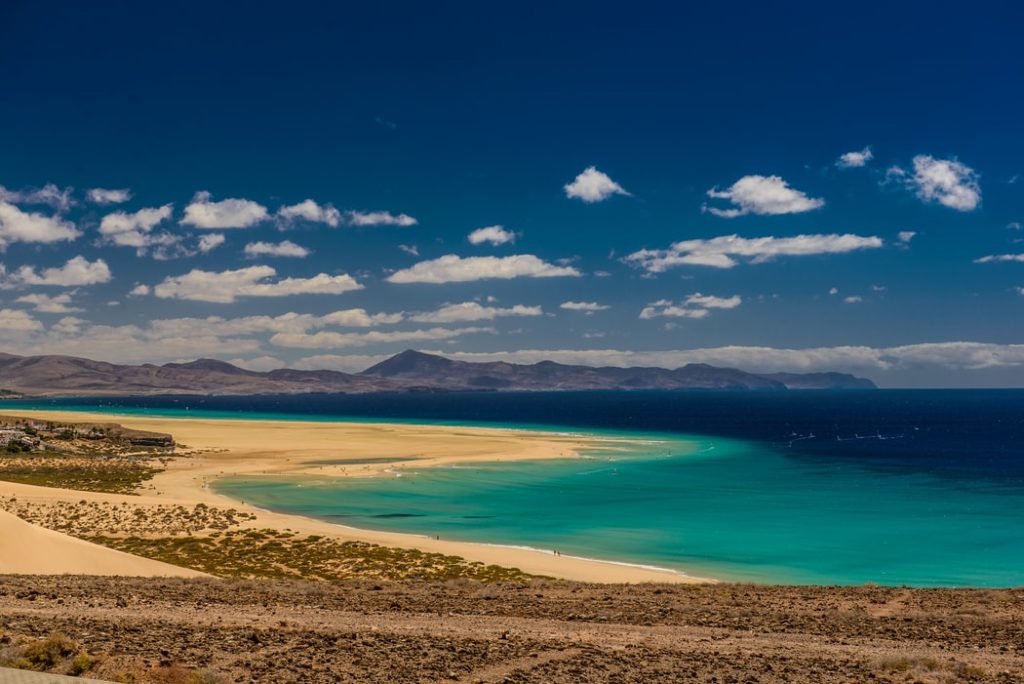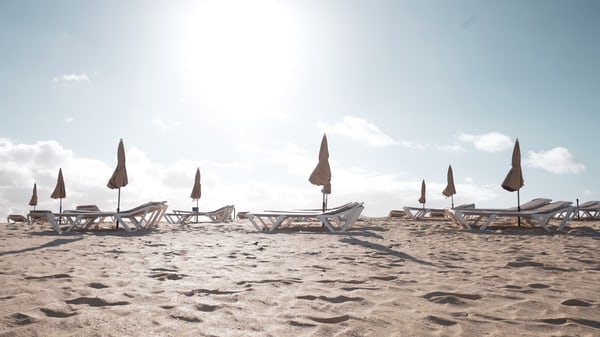
Fuerteventura is the second largest beach coast among Spain’s famous Canary Islands. It is most famous for its majestic beaches, boasting of white and golden sandy shores. The tourism in the island was established quite recently, making it the perfect, underrated tropical getaway destination.
The island is located less than 100 kilometers away from the Sahara Desert, near the border of Western Sahara and Morocco. Fuerteventura enjoys 300 days of sunshine yearly from its subtropical climate. It also also home to Europe’s largest area of desert.
Fuerteventura is ideal for those looking for a laid-back place to unwind. Its pristine beaches stretch miles long, where you can always find a private spot for yourself. The golden shores are not overcrowded with tourists even during the peak seasons.
Each of the main tourist areas in the island has its own distinct personality. These are Corralejo, which is the surfers’ favorite spot and where the night life is; Caleta de Fuste which offers the best secluded beaches and is the closest one from the airport; Costa Calma which has amazing virgin beaches; and Morro Jable/Jandia which has the best weather and stunning beaches.
This island truly has a little something for everyone to enjoy. From surfers looking for some stoke to families looking for a relaxing holiday retreat. Here, you will find everything you need to know before traveling to Fuerteventura.
Currency
The currency that circulates in Fuerteventura is Euros. Conveniently, there are ATM’s located in all resorts on the island. However, there is usually a withdrawal charge of 2% to 3%, depending on the bank. Although most restaurants and resorts accept credit cards, common modes of transportation and local shops or restaurants only take cash as payment. For you to fully experience the authentic goods in the island, you will need cash to avail of them.
Money changers are also available in most seaports and airports. More often than not, money changers offer better rates than banks. Lines and waiting time are relatively faster as well compared to banks. Exchange rates vary in different parts of the island, so feel free to ask for recommendations from your hotel or resort concierge.
Best Time to Visit

The best time to travel to Fuerteventura is in late May to early November, especially between July to October. During this period, you can expect long summer days and a warmer weather with less humidity. It is the sunniest time of the year in the island with minimal to no rainfall.
The beaches are also perfect during this period as the Atlantic Ocean is at its warmest. You will get to enjoy the sunny shores and swim in warm waters. Surprisingly, the beaches are not crowded with locals and tourists even during the warm season.
Transportation

Since Fuerteventura is the longest island in the Canaries, distances between landmarks are longer that you might expect. The airport, in particular, isn’t exactly as well-served by public transportation. That said, it is best to prepare beforehand if you plan on touring different sites in the island.
Fuerteventura has an extensive public bus network run by Tiadhe. However, not all tourist areas in the island do not have direct transport connections from the airport. Corralejo, for example, is not a specific stop on the public bus line. Therefore, travelers must switch to a different bus line in Puerto del Rosario to get to Corralejo.
If you would like the ease of being able to get around the island, taxis are always conveniently available. Taking a cab to get from one point to another within the same locality is fairly affordable. However, if you are going to a different locality, fares surge quickly. For example, a taxi from one locality of Corralejo to the airport in Puerto del Rosario could set you back 50 Euros, while a trip to Morro Jable could cost as much as 150 Euros.
Ironically though, hiring a private car is the most economical and convenient way to get around the Fuerteventura island. For as little as 110 Euros, you can get a private car for a week. Just from getting to and from the airport, this amount is already worth every centavo. It is also a huge plus that you can manage your own time in hopping around the island, without worrying about fare costs.
Tipping
Providing tips is not necessarily obligatory, though most visitors leave a small sum of change for tips. If you are happy with the service, the common tipping rate is 5% of the bill. Local porters who help with your luggage are usually given 1 Euro. Meanwhile, taxi drivers do not expect tips though rounding up on your metered fare would be greatly appreciated.
Visa
Citizens of the European Union member states can travel to Fuerteventura with just their national identity card and a valid passport. Passports must be valid for at least 6 months from the date of arrival, otherwise, you could be denied entry. By law, European citizens are required to bring their identity cards or passports with them at all times while touring around Fuerteventura.
For citizens of Australia, Canada, United States, Japan, New Zealand, and Israel, tourist visas are not required to stay in the island for up to 90 days. Meanwhile, citizens of other countries are generally required to have a Schengen visa.
Schengen visas are quite easy to apply for through the Spanish embassy in your country. Tourist visas are valid for 90 days within a six month period upon approval, and it cannot be extended. Requirements to process a visa differ in each country, just state that the main itinerary for your travel is to visit Fuerteventura.


Thank you very much for sharing, I learned a lot from your article. Very cool. Thanks. nimabi
Enjoy stress-free travel with HR Black Cars for seamless transportation between LAX and Downtown LA. Our dedicated airport service ensures a comfortable ride, connecting you effortlessly to the heart of Los Angeles.
Discover refined airport transportation at airporttransferdfw.com/chauffeur-service-dfw.php. Our chauffeur service offers sophisticated travel to and from Dallas/Fort Worth International Airport. Enjoy a seamless ride with our professional chauffeurs for a stylish and punctual travel experience. Reserve now for a journey tailored to your comfort and convenience.
8scdjx
This is really interesting, You’re a very skilled blogger. I’ve joined your feed and look forward to seeking more of your magnificent post. Also, I’ve shared your site in my social networks!
flb0gs
71ziiw
nwf91i
You’re so creative!
Explore top-notch airport transportation at airporttransferdfw.com. Our luxury car service offers premium travel to and from airports. Enjoy the pinnacle of comfort and style in our high-end vehicles. Book now for a deluxe and reliable travel experience that caters to your schedule and preferences.
Our Airport Limo Services in DFW offers you the best vehicles and drivers at an affordable price
Discover Miami’s vibrant party bus scene with rentals and services offering a variety of options. From stylish party buses to group transportation, find the perfect fit for your Miami event or celebration
Dive into Miami’s party bus scene with varied rental options and services. Browse party buses in Miami, FL, for your next event. Discover stylish and convenient transportation solutions to elevate your celebration experience in Miami.
Explore wheelchair-accessible car services and group transportation alternatives in Washington DC. With a plethora of options, including shuttles and general transportation, the capital ensures seamless travel experiences. Consider KVLIMO for top-tier transportation solutions that prioritize comfort and reliability.
Experience the epitome of luxury and comfort with the website’s premium limousine services in the Bahamas. Whether you need an airport transfer or any other transportation, the professional chauffeurs ensure a lavish and stress-free journey, creating an unforgettable travel experience for the customers.
Airporttransfernassau.com is the place to find Nassau Airport to Warwick Paradise Island transportation and rates. We offer safe, reliable, and professional transportation services from Nassau Airport to Warwick Paradise Island for all your needs!
Bahamas Premium Transfers is proud to serve private transportation from Nassau Airport to Paradise Island with professional cheuffeur. As a leader in transportation and special event chauffeur services,
Niagara Falls Cab Company, a reputable transportation service in Niagara Falls, Ontario, prioritizes passenger satisfaction with safe, reliable, and punctual travel solutions, including airport transfers and local rides.
Discover top-notch airport taxi service in Kawartha Lakes City. Easily book a taxi or cab to the airport in Kawartha Lakes City. Our professional drivers ensure timely and comfortable rides. Find me a taxi in Kawartha Lakes City today.
Make your journey exceptional with Deerhurst airport limo. We provide top-notch Deerhurst airport luxury transportation, dependable Deerhurst airport taxi, and efficient Deerhurst airport Shuttle services for your travel needs.
Enjoy hassle-free Airport Transportation to Ohare with our reliable services. From luxury sedans to executive car service, we ensure comfort and punctuality for your airport transfers. Experience seamless transportation solutions tailored to your needs.
Enjoy top-tier Manhattan limo service with our luxury fleet. From corporate events to weddings, our Manhattan limousine rental and chauffeur service ensure a seamless ride. Book your Manhattan airport limousine service today.
Luxury airport transport in Cape Town ensures a seamless travel experience with top-notch chauffeur services and luxury vehicles. Ideal for travelers seeking elegance, comfort, and convenience.
Trust Houston Shuttle Service for your Houston Airport shuttle service needs. Offering IAH shuttle service and Hobby Airport shuttle service, our Houston shuttle transportation service ensures punctual and efficient travel to and from Houston airports.
If you’re in need of a chauffeur in Dubai, then look no further. At Dubai Hummer Limo Services (DHL) we offer the best chauffeur service and luxury car service in town.
Elevate your Dubai experience with Mercedes Sprinter Dubai’s lavish limo services, featuring elegant limousines and expert chauffeurs for a touch of sophistication.
A Mercedes Sprinter is one of the most popular luxury vans in Dubai, and it is loaded with features to make it more comfortable and convenient.
Little Stars Travel offers impeccable luxury car services in Dubai. With a fleet of top-tier vehicles and professional chauffeurs, they provide a premium transportation experience. Whether for business or leisure, their services ensure a stylish, comfortable, and reliable journey throughout Dubai’s vibrant cityscape.
Temp Mail Hi there to all, for the reason that I am genuinely keen of reading this website’s post to be updated on a regular basis. It carries pleasant stuff.
Temp Mail Hi there to all, for the reason that I am genuinely keen of reading this website’s post to be updated on a regular basis. It carries pleasant stuff.
Temp Mail very informative articles or reviews at this time.
Temp mail Nice post. I learn something totally new and challenging on websites
The degree of my admiration for your work is just as great as your personal opinion. Your visual presentation is elegant, and the authored content is both fashionable and interesting. However, it appears that you are apprehensive of delivering something that may be seen as dubious. I believe that we will be able to resolve this issue quickly and effectively.
11 After OHSS induction day 6, these rats were randomly allocated into three groups, yielding a total of four groups group 1 n 5, 35 day old control group age matched group; group 2 n 5, OHSS rats decapitated at age 35 days without any intervention; group 3 n 5, 27 day old OHSS rats that were decapitated following oral administration of 1 mg kg of tamoxifen Nolvadex, AstraZeneca, UK for 7 days 27 7 day 1 mg kg of tamoxifen, decapitation on day 35; and group 4 n 5, 27 day old OHSS rats that were decapitated following oral administration of 3 mg kg of tamoxifen 27 7 days of 3 mg kg of tamoxifen, decapitation on day 35 priligy precio For example, treatment may be administered to a susceptible individual prior to the onset of symptoms e
Real Estate Very well presented. Every quote was awesome and thanks for sharing the content. Keep sharing and keep motivating others.
Tech to Force I just like the helpful information you provide in your articles